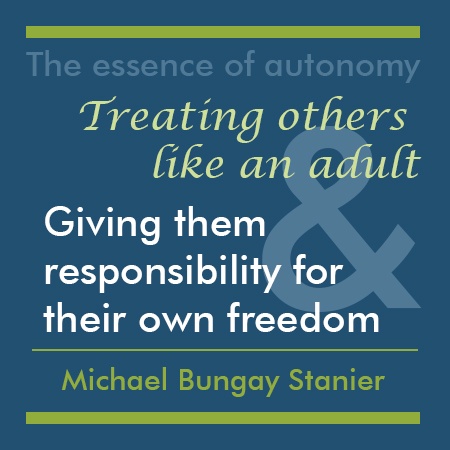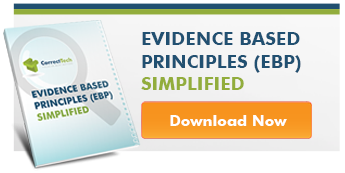The first three questions of The Coaching Habit: Say Less, Ask More & Change the Way You Lead Forever that are discussed Kickstarting a Coaching Session, Coaching with the AWE Question, and The Coaching Habit of Creating Focus, work together to create focus and define what the client sees as the central problem. As we have discussed earlier, it is tempting to believe that your work is primarily done once the problem is solved. The Advice Monster will see a clear definition of the problem as an opportunity to solve it, look brilliant and move on to the next problem. No patience, process or angst required. Most of us went into this field due to our passion to help others. Somehow along the way, we learned that helping others means attempting to solve problems for them. Well intentioned but well off the mark. “What is the real challenge here for you?” isn’t the beginning of the end, it is the end of the beginning. The first half of the coaching process is defining the problem. The second half is identifying the solution. That process begins with a simple (but not easy) question?
Read MoreThe Foundation of Coaching: Respecting Autonomy
Posted by Evan C. Crist, Psy.D. on 9/13/18 7:44 PM
Topics: The Coaching Habit, Michael Bungay Stanier, Evan C. Crist, coaching community corrections clients
The Coaching Habit of Creating Focus
Posted by Evan C. Crist, Psy.D. on 8/14/18 11:44 AM
After cutting through the fog of small talk and vague concerns with the Kickstart Question and a series of And What Else? questions, you have narrowed the focus. Perfect. Time to fix it, right? Wrong. It is time to slow down your urge to believe your brain that you know the problem and have the solution. Narrowing the focus is different than specifically defining the problem. You are getting closer but aren’t there yet.
The third question in Michael Bungay Stanier’s The Coaching Habit: Say Less, Ask More and Change the Way You Lead Forever is the Focus Question. “What’s the real challenge here for you?” We’ve addressed the danger of the Advice Monster in a previous blog and it is most likely to attempt to take over the discussion here. Your frontal lobe is now convinced it fully understands the issue and the advice monster is eager to do its bidding. The Advice Monster impulsively disagrees with a basic tenet of therapeutic intervention; It is our job to expose the client’s values and desires, not to impose our values and desires. Unsolicited advice is an attempt to impose our values on a client. You are in good company. We all have that urge. Instead, let’s find out what the real challenge is for them at this moment.
Read MoreTopics: client development, The Coaching Habit, Evan C. Crist, coaching community corrections clients, client needs and values, the awe question
Kickstarting Offender Coaching: Practical Strategies for Building Trust and Change
Posted by Evan C. Crist, Psy.D. on 7/6/18 11:08 PM
Key Takeaways:
- Effective coaching starts with trust—build rapport early by focusing on the client’s concerns rather than a preset agenda.
- CorrectTech supports this process by integrating evidence-based practices with real-world case management tools.
- Balancing structure with flexibility ensures each session meets clients where they are, increasing engagement and motivation.
Topics: Community Corrections Professional, Listening Skills, The Coaching Habit, Community Corrections Client Services, Developing a practice model, Evan C. Crist, Switch by the Heath Brothers, what's on your heart, coaching community corrections clients, reaching clients emotions
Developing a Practice Model
Posted by Evan C. Crist, Psy.D. on 12/28/16 3:02 PM
This blog is a continuation of the EBP Practice Models blog series started by this blog’s author Evan C. Crist, Psy.D. and other industry leading authorities on practice models, Brad Bogue, Matt Moore and Tom O’Connor.
When Brad Bogue first suggested we work on a “practice model” I was embarrassed to admit I had no idea what he was talking about. After a bit of research I realized that, while the term was foreign to me, the concept was not that complicated and was a logical extension of our agency’s evidence-based practices (EBP) training. I learned that practice models structure the use of various EBPs into a logical, coherent process to help practitioners identify the next necessary step in the intervention sequence.
Armed with lots of knowledge about EBP, but without a framework to identify and organize what techniques to use when, we recognized we did, indeed, need a practice model. Since I am writing this blog during the Christmas season, it seemed that we had lots of ornaments and tinsel but no tree on which to hang them. It became clear that without a practice model we would remain knowledgeable about EBP but unskilled in their delivery.
I looked at several of the prepackaged practice models available but found all of them lacking. They were either incongruous with my clinical experience (e.g., the importance of building motivation was essentially ignored) or contradicted my philosophy of the change process (e.g., they followed a manual but left little room for situational flexibility). With Brad at my side challenging my assumptions every step of the way, we decided to develop a practice model in house. We facilitated the process while our capable staff of case managers merged research with their experience and theory with reality.
It was a vital learning experience for me. I thought I needed to teach the case managers to think; turns out, I simply needed to create the space and let them think.
We started with the necessary requirements for the practice model:
- It must include a variety of interventions.
- It must include evidence-based, evidence-informed or promising practices.
- It must be coherent.
- It must be simple but powerful.
- It must include situational flexibility.
Topics: Policy, Practices, Change, Community Corrections Client Services, Developing a practice model, Evan C. Crist
Subscribe To Our Blog
Recent Posts
Posts by Topic
- Community Corrections (63)
- Evidence Based Practices (44)
- Community Corrections Professional (23)
- Software (15)
- Practices (12)
- Change (11)
- Technology (10)
- Risk Principle (8)
- reentry (8)
- probation staff (7)
- EBP (6)
- Outcomes (6)
- client development (6)
- client needs and values (6)
- coaching community corrections clients (6)
- Assessment (5)
- Community (5)
- Developing a practice model (5)
- Justice-Involved Clients (5)
- Remote work (5)
- The Coaching Habit (5)
- parole (5)
- risk (5)
- tele-supervision (5)
- tele-work (5)
- Community Engagement (4)
- Evan C. Crist (4)
- Community Corrections Client Services (3)
- Criminal Justice Reform (3)
- Implementation (3)
- Listening Skills (3)
- Motivational Interviewing (3)
- Policy (3)
- Positive Reinforcement (3)
- Practice Models (3)
- high risk client (3)
- reaching clients emotions (3)
- responsivity (3)
- Addiction (2)
- BOP (2)
- Conferences (2)
- ICCA (2)
- Management (2)
- Michael Bungay Stanier (2)
- Relapse Prevention (2)
- halfway house (2)
- jic (2)
- principles (2)
- procedures (2)
- program results (2)
- APPA (1)
- Appreciative Thinking (1)
- Brian Lovins (1)
- COVID-10 (1)
- Community Connection (1)
- Coronavirus (1)
- Crisis (1)
- Customer Service (1)
- Data Management (1)
- Fidelity (1)
- ICCA Seattle (1)
- Juvenile Corrections (1)
- Leadership (1)
- Monitor History (1)
- Opioid Addiction (1)
- Opioid Crisis (1)
- Orange is the New Black (1)
- Program Data (1)
- Reforms (1)
- Relapse (1)
- Second Chances (1)
- Switch by the Heath Brothers (1)
- Treatment (1)
- drug testing (1)
- going paperless (1)
- govcio outlook (1)
- impact sessions (1)
- innovation (1)
- intrinsic motivation (1)
- justice reinvestment (1)
- marijuana testing (1)
- money savings (1)
- opiod testing (1)
- paperless office (1)
- purpose (1)
- remote working (1)
- resources (1)
- sanction (1)
- staff productivity (1)
- technology solutions provider (1)
- the awe question (1)
- what works (1)
- what's on your heart (1)
- work from home (1)






